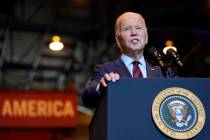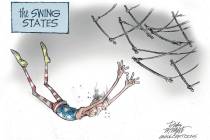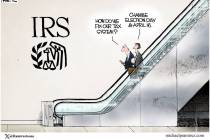EDITORIAL: Legislature must pass pension reform bill
Following the logic of those who defend the Nevada Public Employees Retirement System is no easy task. But let’s try.
Government employees, union leaders and PERS officials themselves have said Nevada’s pension system is sound, yet so underfunded that it can’t be abandoned. Even though the state’s taxpayers can’t afford it, future government hires must be promised the same benefits as current employees and retirees, because the stable system is too unstable to do otherwise.
Got it? If not, you’re not alone. The argument is a slap to the public: “Even if you try to reform PERS, you’ll end up paying us anyway. There is no escape.”
But there is an escape, and it starts with the Nevada Legislature passing Assembly Bill 190. As the Review-Journal’s Sean Whaley reported, Assemblyman Randy Kirner, R-Reno, testified Wednesday in support of his bill, which would establish a new hybrid retirement plan for Nevada public employees hired on or after July 1, 2016.
The plan, Mr. Whaley noted, would have a 6 percent employer contribution to a defined-benefit plan to account for the fact that Nevada’s public employees do not participate in Social Security. Also, for regular employees, there would be a defined-contribution plan, with 6 percent contributed by the employer and 6 percent by the employee. An additional 6 percent employer contribution would be applied to the unfunded liability of the existing plan, though the new plan would halt the growth of that liability, currently pegged at about $12.5 billion.
These retirement contribution rates would be lower than the current 28 percent for regular government employees and 40.5 percent rate for public safety employees. Yet the contributions are still far better than what most private-sector employees receive — if they receive any employer contribution at all.
Contribution rates to the existing PERS plan will continue to rise as long as new employees are added to the system. Those pension contributions are squeezing government services, from schools to police to parks. And the more those services are squeezed, the more pressure is created for higher taxes to fund public-sector retirements — to pay people who aren’t working, instead of those who are working.
Of course, union leaders have called AB190 a Republican assault on the middle class. But PERS is not a middle-class benefit — it provides upper-class income and retirement security at the expense of taxpayers who can’t afford to save for themselves. For a private-sector worker to retire at age 50 and guarantee himself $100,000 per year in income, he’d have to have millions of dollars in savings. If you have seven figures in the bank, you’re not middle class.
There’s an assault going on here, all right — on logic. PERS’ unfunded liability would be dramatically smaller if the plan were a retirement benefit given at an actual retirement age. PERS is underfunded because it’s not a retirement benefit — government workers can retire in their 40s or 50s, then embark on a new career while collecting a lucrative pension for perhaps 40 years — longer than they actually worked for a government. Shortening the window during which government retirees can receive benefits would make PERS more sustainable. Mr. Kirner’s bill would establish a minimum public employee retirement age on par with Social Security eligibility.
The Assembly and Senate should see to it that the bill makes it to the desk of Gov. Brian Sandoval. Logically, he should waste no time signing it.























